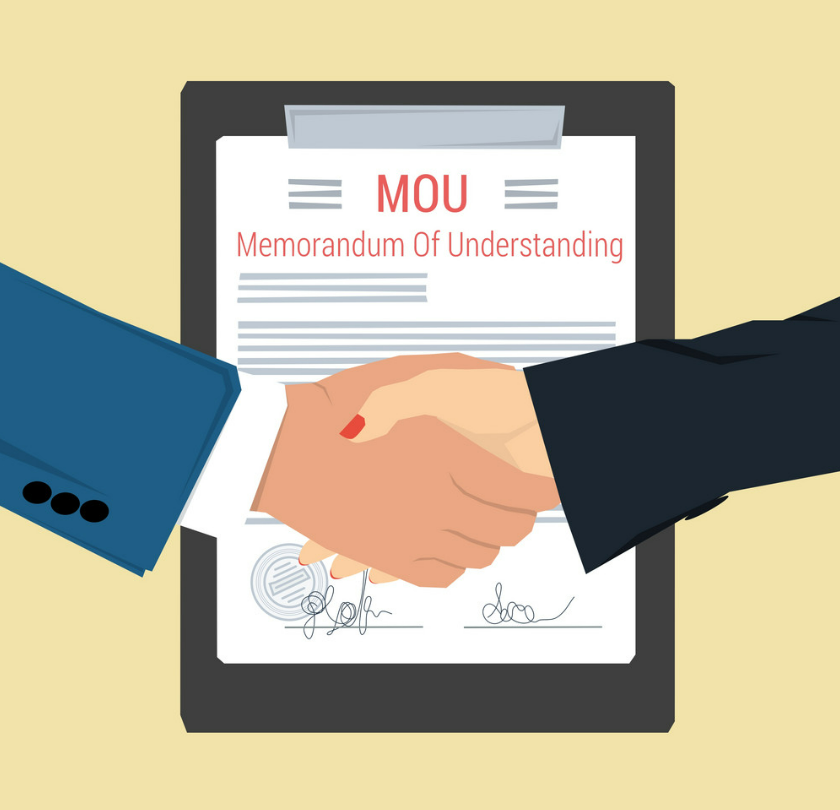Memorandum of Understanding
When draftA Memorandum of Understanding (MOU) is a non-binding agreement between two or more parties that outlines the terms and details of a cooperative relationship or understanding. While an MOU is not legally binding like a contract, it serves as a preliminary document that lays the foundation for future negotiations and agreements. Here’s what you need to know about a Memorandum of Understandinging a vendor agreement, it’s important to be thorough and clear about the terms and conditions of the arrangement. Below is a structured outline to help you create a comprehensive vendor agreement:

What is Memorandum of Understanding
Parties Involved: Clearly identify the parties entering into the MOU, including their legal names, addresses, and contact information.
Purpose and Objectives: Describe the purpose, goals, and objectives of the collaboration or cooperation outlined in the MOU. Clearly state the intended outcomes and benefits for all parties involved.
Scope of Cooperation: Define the specific areas or aspects of cooperation covered by the MOU, including the activities, projects, or initiatives to be undertaken jointly.
Roles and Responsibilities: Outline the roles, responsibilities, and contributions of each party to the collaboration. Specify the tasks, activities, and resources that each party will provide or undertake.
Duration and Term: Specify the duration or term of the MOU, including the start date and end date, if applicable. Clarify any provisions for renewal or extension of the agreement.
Non-Binding Nature: Clearly state that the MOU is a non-binding agreement and does not create legally enforceable obligations or rights between the parties. Emphasize that the parties are not legally obligated to follow through with the cooperation outlined in the MOU.
Confidentiality and Non-Disclosure: Include provisions to protect the confidentiality of sensitive information shared between the parties during the collaboration. Specify obligations for maintaining confidentiality and restrictions on disclosing information to third parties.
Dispute Resolution: Establish procedures for resolving disputes or disagreements that may arise during the collaboration. Specify mechanisms for negotiation, mediation, or arbitration to address conflicts and disputes amicably.
Termination Clause: Include provisions for terminating the MOU by either party, with or without cause, and specify the notice period and procedures for termination.
Governing Law and Jurisdiction: Determine the governing law and jurisdiction that will apply to the interpretation and enforcement of the MOU, especially if the parties are located in different jurisdictions.
Signatures and Execution: Provide space for authorized representatives of each party to sign and date the MOU, indicating their agreement to the terms and conditions outlined in the document.
Types of Memorandum of Understanding
General Collaboration MOU: This type of MOU outlines the broad areas of cooperation and collaboration between two or more parties. It establishes the framework for future interactions and joint initiatives without specifying detailed obligations or commitments.
Project-Specific MOU: Project-specific MOUs are used to outline the terms and conditions of cooperation for a particular project or initiative. They define the roles, responsibilities, timelines, and deliverables associated with the project, as well as any resources or funding commitments.
Research and Development MOU: Research and development MOUs are commonly used by academic institutions, research organizations, and industry partners to formalize collaborations related to scientific research, technology development, or innovation projects. They specify the objectives, methodologies, data sharing arrangements, and intellectual property rights related to the research activities.
Partnership MOU: Partnership MOUs establish formal relationships between organizations, agencies, or entities for the purpose of pursuing common goals, delivering shared services, or advancing mutual interests. They may cover areas such as joint marketing efforts, resource sharing, advocacy campaigns, or capacity building initiatives.
Trade and Commerce MOU: Trade and commerce MOUs are agreements between governments, trade associations, or businesses aimed at promoting trade, investment, economic development, or regulatory cooperation. They may address issues such as market access, tariff reductions, standards harmonization, or business facilitation measures.
Education and Exchange MOU: Education and exchange MOUs facilitate partnerships between educational institutions, cultural organizations, or exchange programs to promote academic cooperation, student exchanges, faculty collaboration, or cultural exchanges. They may include provisions for curriculum development, student mobility, faculty exchanges, or joint research projects.
Resource Sharing MOU: Resource sharing MOUs enable organizations to pool resources, expertise, or facilities for mutual benefit. They may involve sharing of equipment, facilities, personnel, or services to enhance efficiency, reduce costs, or expand capabilities.
Government and Non-Governmental Organization (NGO) MOU: MOUs between governments and non-governmental organizations (NGOs) are used to formalize partnerships for development projects, humanitarian assistance, disaster relief efforts, or public service initiatives. They establish roles, responsibilities, and coordination mechanisms between government agencies and NGOs.
International MOU: International MOUs are agreements between governments, international organizations, or multinational corporations that govern cross-border cooperation, diplomatic relations, trade agreements, or international development initiatives. They address issues of mutual interest, diplomatic protocol, and legal frameworks for international collaboration.
Sister City or Twinning MOU: Sister city or twinning MOUs establish formal relationships between cities or municipalities in different countries for the purpose of cultural exchange, economic cooperation, tourism promotion, or citizen diplomacy. They facilitate partnerships between local governments, community organizations, and citizens of twinned cities.
When Is an MOU Agreement Used
Partnership Formation: Organizations or entities may use MOUs to establish formal partnerships or alliances to pursue common goals, share resources, or undertake joint initiatives. This could include partnerships between businesses, non-profit organizations, government agencies, academic institutions, or international organizations.
Pre-Negotiation Stage: In business or diplomatic negotiations, parties may use MOUs as a preliminary agreement to outline the key terms and principles that will guide subsequent negotiations. An MOU can serve as a framework for further discussions and the development of more detailed agreements.
Project Collaboration: When multiple parties are involved in a specific project or initiative, an MOU can define the roles, responsibilities, and contributions of each party, as well as the scope, objectives, timelines, and deliverables of the project. This helps ensure clarity and alignment among the project stakeholders.
Research and Development: In scientific research, technology development, or innovation projects, MOUs can formalize collaborations between research institutions, universities, industry partners, and government agencies. They may outline agreements related to data sharing, intellectual property rights, funding arrangements, and research methodologies.
Cross-Border Cooperation: MOUs are commonly used in international relations to facilitate cooperation and coordination between countries, international organizations, or regional entities. They may address issues such as trade agreements, diplomatic relations, security cooperation, environmental protection, or cultural exchanges.
Education and Exchange Programs: Educational institutions, cultural organizations, and exchange programs use MOUs to formalize partnerships for student exchanges, faculty collaboration, joint research projects, and cultural exchanges. MOUs outline the terms and conditions of the exchange program, including academic requirements, funding, and logistical arrangements.
Resource Sharing and Collaboration: Organizations may use MOUs to formalize agreements for sharing resources, expertise, facilities, or services for mutual benefit. This could include sharing of equipment, facilities, personnel, or expertise to enhance efficiency, reduce costs, or expand capabilities.
Inter-Governmental Relations: MOUs are commonly used by government agencies at the local, regional, national, or international levels to establish formal relationships, coordinate activities, and address shared challenges or opportunities. They may cover areas such as law enforcement, emergency response, public health, or infrastructure development.



Features of Memorandum of Understanding Agreement
Parties to the Agreement: Clearly identify the parties entering into the MOU, including their legal names, addresses, and contact information.
Purpose and Objectives: Describe the purpose, goals, and objectives of the collaboration or cooperation outlined in the MOU. Clearly state the intended outcomes and benefits for all parties involved.
Scope of Cooperation: Define the specific areas or aspects of cooperation covered by the MOU, including the activities, projects, or initiatives to be undertaken jointly.
Roles and Responsibilities: Outline the roles, responsibilities, and contributions of each party to the collaboration. Specify the tasks, activities, and resources that each party will provide or undertake.
Duration and Term: Specify the duration or term of the MOU, including the start date and end date, if applicable. Clarify any provisions for renewal or extension of the agreement.
Non-Binding Nature: Clearly state that the MOU is a non-binding agreement and does not create legally enforceable obligations or rights between the parties. Emphasize that the parties are not legally obligated to follow through with the cooperation outlined in the MOU.
Confidentiality and Non-Disclosure: Include provisions to protect the confidentiality of sensitive information shared between the parties during the collaboration. Specify obligations for maintaining confidentiality and restrictions on disclosing information to third parties.
Dispute Resolution: Establish procedures for resolving disputes or disagreements that may arise during the collaboration. Specify mechanisms for negotiation, mediation, or arbitration to address conflicts and disputes amicably.
Termination Clause: Include provisions for terminating the MOU by either party, with or without cause, and specify the notice period and procedures for termination.
Governing Law and Jurisdiction: Determine the governing law and jurisdiction that will apply to the interpretation and enforcement of the MOU, especially if the parties are located in different jurisdictions.
Signatures and Execution: Provide space for authorized representatives of each party to sign and date the MOU, indicating their agreement to the terms and conditions outlined in the document.
